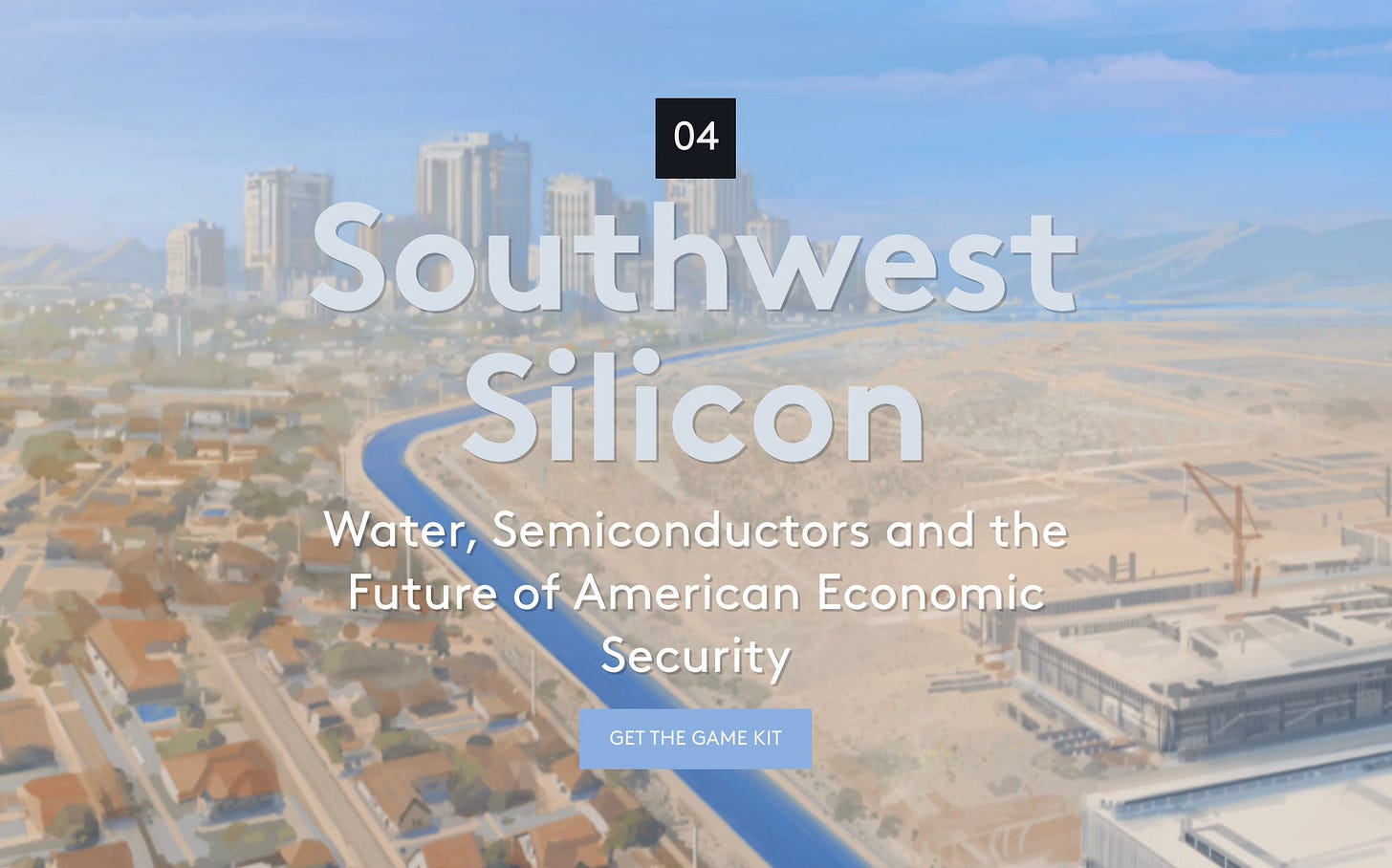Behind the scenes of Southwest Silicon, our new Riskgaming scenario
Dive into the world of water, chip fabs, and Arizona politics with our new game launched this morning
Arizona is arguably the most pivotal swing state in America today, home to a newly-built TSMC chip fab and a burgeoning silicon ecosystem. It’s also running out of water, activating a doomsday clock that sets the state’s future on a cataclysmic path with the needs of its current and future citizens.
Yes, it’s the alfalfa. Yes, it’s the golf courses and swimming pools that dot the bone-dry desert. Yes, it’s the new chip fabs. Yes, it’s the massive population growth in one of the most inhospitable environments to humans in the continental United States. And yet, like the metaphorical beast, Phoenix is rising from the sands of the geologic past to become one of the most important global regions of the 21st century. How the city and Arizona more broadly manage that crucial three-atom elixir of life will determine the destiny for themselves — and all of us.
Southwest Silicon is a brand-new, full-immersion Riskgaming scenario for 8-9 players that simulates the tough economic, social and political tradeoffs of the American Southwest. We’re launching it today, and all of the materials that you need to play are now available for download.
The game was created by Ian Curtiss, our independent Riskgaming scenario designer who lives in Phoenix and has watched as the hulking concrete structures of chip fabs and office parks have emerged from the wilds.
The gameplay of Southwest Silicon centers on water rights and the frenetic competition — and requisite tradeoffs — over these all-important legal contracts that can be bought and traded across dozens of stakeholders with their own interests and biases. Ian modeled Arizona’s water market after extensive research and real-world reporting, capturing both the obvious economic implications of these trades but also their direct and indirect effects on families and communities.
Three players are the mayors of Phoenix, Chandler and Peoria, all trying to attract brand-new industries to their cities in spite of residential growth and increasingly scarce water supplies. Droughts are an omni-present threat, potentially triggering water shortages that can lead to immediate drops in polling and a political crisis. Should you gamble the city’s future through over-expansion that might never be a problem in the end? Or should you play it safe, but potentially lose a crucial economic development project to another regional city?
One player takes on the role of the governor of the Gila River Indian Community in central Arizona. The nation has bountiful water resources, but has its own challenging tradeoffs to balance like protecting its Native American legacy and influence while also taking part in Arizona’s economic success.
Other players take on the role of politicians trying to pass legislation that changes the game’s rules, consultants who are brokering deals for profit, and the local executive of the chip fab, who wants the best deal possible to drive the company’s stock price to its highest levels yet.
Southwest Silicon is a local game with global implications, one that we have played in the United States as well as in Europe and Asia. The challenge of growing under constraints is a commonplace, and the liminal space between positive-sum growth and doom-loop collapse can be astonishingly narrow.
In short: get a group together, play the game, and let us know what you think!
For today’s Riskgaming podcast, I talked with Ian about how he approached designing the game, what he learned in the process, and what the experience can teach players.
This interview has been edited for length and clarity. To hear more of the conversation, please subscribe to our Riskgaming podcast.
Danny Crichton:
Ian, your game centers on all these new chip fabs coming into Arizona. The context is obviously the Biden administration’s passage of the Chips and Science Act, which provided $55 billion of subsidization for the chips industry. Those loans and grants were sent out to TSMC, Intel, Samsung and others.
We go to DC, and a lot of people are interested in the growth, jobs, and economic development these new fabs could bring. But one angle that has been undercovered is water security. Arizona is a desert. Chip fabs are some of the greatest water guzzlers anywhere in the world. The Colorado River has had historically low water levels.
You created this game essentially to capture what you were seeing in your own hometown of Phoenix. Tell us a little bit about your story here and what you brought from your own personal experience into the game.
Ian Curtiss:
Yeah, I’m calling in from Phoenix, Arizona in the middle of the desert. When I moved here as a kid, I was like, “Nothing should be here. This is a miserable place. Why does anybody live here?” And yet there’s a miracle to this place because of the water brought in from the Colorado River. It’s this incredible feat of humanity that we can move water across the world in this way.
Where is water going to come from in the future? It’s a fascinating blend of angst and endless hope and faith. There’s angst about the water, but then there’s this endless belief in humanity’s ability to find more.
As you said, the water guzzlers — chip fabs — are rapidly expanding in the Phoenix Valley. So there’s this ongoing conversation around water. Where is water going to come from in the future? It’s a fascinating blend of angst and endless hope and faith. There’s angst about the water, but then there’s this endless belief in humanity’s ability to find more.
There’s all sorts of wonderful books and stories about this stuff. Cadillac Desert was written, I think, 40 years ago now. And it’s a wonderful book that goes into the history of the American West. Essentially the Bureau of Land Reclamation — it all started in the FDR days — said, “let’s start building dams and aqueducts to get water to the American West,” because it was underpopulated compared to the east. And one of those projects, of course, was the Hoover Dam on the Colorado River. And all this led to water being able to create Phoenix, Arizona.
When you’re in Phoenix today, there’s such rapid growth of suburbia. It’s urban sprawl on steroids times ten. And now all the chip fabs are coming into town. TSMC is making the largest investment in American history building its fabs out in Arizona. The most recent update was to promise that 30% of its three-nanometer (3nm) technology would be produced in Arizona at some point in the future. We’re reaching this interesting point where: What happens? Does this boil over, or rather, dry up? And where do we go from here? And so that was really why I wanted to make this game.
Danny Crichton:
You’ve had farming in Arizona for a long time, in some cases over a hundred years. And then you have these two new green shoots for the city. One is residential growth, as you were saying. You have hundreds of thousands of people moving into the region — all across Arizona, New Mexico, Southern California — who are looking for warmer temperatures trying to escape the New England winter. And then there are these semiconductor plants, each of which use millions of gallons of water potentially each day.
And so you have this unique tension between old industry, new industry, old population, new population, which makes for a great Riskgaming scenario. Maybe you could talk a little bit about how this plays out with the stakeholders within the game.
Ian Curtiss:
With industrial policy, it’s so local. But the core of any policy is that you end up creating winners and losers. And so when you start throwing government money around, and when you start getting such huge investments into an area like chip fabs, it can make or break a community. It literally changes the daily lives of people to have this kind of investment.
And so the stakeholders, they are a series of NPCs I put into the game. They’re a way for the eight to nine people who sit around the table playing the game to watch Arizona change based on the decisions they’re making. Some are farmers, a good many represent everyday businesses. Some are existing chip fabs.
The core of any policy is that you end up creating winners and losers.
And so me, as a player, as I’m playing the game, I am getting data feedback at the end of every scene about what my stakeholders want. I’m trying to calculate not only the opinions of the people around the table as I negotiate with them about what I should do in the game, but I’m also having to keep in mind these NPCs that still have an opinion on the matter at hand — much like real political life. They might not be at the table, but they still have an impact on the outcome.
Danny Crichton:
Arizona is one of the most contested battleground states in the country. You have a split legislature, you have a split in state-level offices and in the congressional delegation. One of the things we tried to include in this game is the factional dynamic between farmers who are Republican, farmers who are Democrat, new business owners on both sides. It’s not always easy when you have several dozen stakeholders to build up a coalition of people who all support you. You take one action, their responses don’t necessarily line up perfectly with each of those adjectives and characterizations. That creates a much more dynamic and I think rich game in Southwest Silicon compared to a lot of our others. So I’m really excited for people to try the stakeholder model.
Obviously, the best way to learn from the game is to play it. But what do you think are some of the key takeaways you want people to experience?
Ian Curtiss:
Well, first and foremost: water as a topic. The factoid I love to drop is that the most recent time one U.S. state deployed troops against another was in the 20th century over the Colorado Dam. Arizona sent troops to the Colorado River to try to stop California from building a dam that Arizona had not yet agreed to. So water is this incredibly poignant, critical asset that people need to survive. People are literally willing to deploy forces to protect it.
When somebody says there’s not enough water, the implication is that there’s not enough water for everybody to have everything that they want, but there is enough water for certain things to be chosen over others.
Beyond that, though, is the winners/losers dynamic. When you see news about drought, you see how this person is going to win from water, this person’s going to lose from water, there’s plenty of water for data centers, there’s not enough water for data centers, chip fabs are using all the water. You have to get more detailed and granular about the local realities of water and understand where the water comes from and understand who’s going to get the water and who’s not.
Water is a commodity. It can be bought and sold, so economics is inevitably going to be the decider. When somebody says there’s not enough water, the implication is that there’s not enough water for everybody to have everything that they want, but there is enough water for certain things to be chosen over others. I will pay more for water than you will, therefore, I get to water my plants more than you do.
But society is going to be choosing not only based on economics — taxing and so forth — but also on the infrastructure required to get water where it needs to go. And this gets back to my earlier point about the BLR, the Bureau of Land Reclamation. There’s all these little water districts across the American West with localized water prices, and sometimes they’re significantly cheaper in one district than they are in another, even just a mile away, because 40 or 60 or 70 years ago when the dams and aqueducts were built, one of the dams or the aqueducts was far more expensive to build than the other.
So here we are now: these water districts are not very economically productive ways to use this water, and a chip fab wants to come into Arizona. So where’s that water going to come from? This game works through how people will wrestle with these decisions: Do we want farmers to have water? Do we want chip fabs to have water? Do we want houses to have water? And if it’s not the farmers in Arizona, then where’s American going to produce its lettuce?
Danny Crichton:
When I think about the takeaway, we’re trying to complicate the picture a little bit. We’re not trying to complicate it so much that people are lost, but we’re trying to take something that has been very simple, very one-dimensional, usually around economic growth. We’re trying to add in a lot of other factors that people aren’t necessarily aware of. We’re taking advantage of your local knowledge in Phoenix and we include a lens on U.S. politics, specifically the balance between local affairs versus federal affairs.
There’s a little bit of a plot twist in the game that also highlights the individual versus collective goals of different groups of people and how sometimes, even if you’re a politician or a CEO, your personal motivations can become incompatible with your leadership goals.
I think Southwest Silicon is a great example of Riskgaming at its finest. It brings together a lot of different trade-offs that people are not necessarily considering. So I think it’s very mind-expanding, and I’m looking forward to everyone playing it.
We just played this game in London with some British bureaucrats and locals. Were there any surprises from that group? I think some people knew where Arizona was, but most did not.
Ian Curtiss:
Well, first off, I have to defend my home state of Arizona. They did know where Arizona was, they just didn’t know where all of our cities were.
But the game in London was great fun because, again, it’s so local. Brits expect water to fall from the sky everywhere they go, and that leads to many assumptions about how your society would function and about the role of infrastructure and localized economic policies and decision points. When we did the game pre-briefing, we quickly realized the players weren’t used to mayors making these sorts of decisions. They weren’t used to it being an issue that a mayor could buy or sell water with local businesses.
What was really fun was watching, as with any culture when we go around the world and play these games, how different people play the game differently. For one, our British friends had a blast stepping into American roles, and some of them were like, “Oh, well, if I’m going to be an American, I’ll be American.” And they leaned into the role-playing aspect.
The last thing, though, was their perspective on the chip development process. And again, as an American, we just take for granted that chips are an American-designed thing. For the players in London, so much of the content wasn’t as naturally a part of daily life. So that was the other interesting thing — catching them up on some of these assumptions about the chip fab investments, what they mean, the laws, the process for the CHIPS Act to be expanded. Getting our friends from across the pond to wrestle with these things was a blast.
Danny Crichton:
I want to go broader. We beta tested this game with a lot of folks. We’ve been designing and producing it. We’ve got booklets here now, so it’s all coming together. But there’s water issues going on all over the place.
One big story this summer came from China, a place you lived in for a very long time. Last week, Premier Li Qiang announced the construction of a new dam in the Tibetan Plateau at a current cost of $170 billion. This is the largest dam ever built in the world, projected to potentially produce as much as 3–4% of China’s GDP. It would produce enough electricity to power all of Britain. I talked about it in a newsletter back in July.
What was your take on this? You spent six years in Beijing, and you’re still doing a lot of work there. Were you surprised by this announcement and the scale?
Ian Curtiss:
What was so fascinating to me was, first, well, it’s China being China, right? Incredible projects, incredible mobilization of capital. I mean, there are theories that centralized projects to protect people from drought and flooding along the Yangtze and Yellow Rivers are core to Chinese political identity. And so now you see this play out in Tibet.
Wherever we’re at with these topics, the Chinese government has been thinking about them for at least a decade longer and in far more depth and nuance.
The second thing that came up for me was a memory of a hugely impactful moment in my time in China. We had a course on non-traditional security, and water security was one of the issues we talked about. There was also ag security, there was biosecurity. At the time, the foreign students thought all these topics were just Chinese communist paranoia. Like, “the market will take care of this if you would just get out of the way.” Well, here we are, and what is the U.S. government talking about every day? All these non-traditional security topics. The Chinese government has been thinking about them for at least a decade longer and in far more depth and nuance.
But regarding water specifically, there’s another thing that’s interesting about this game and the development in Tibet. Throughout the PRC’s expansion into Tibet and Xinjiang, there was open talk about applying U.S. government methodologies to Native American tribes in the Chinese West and South.
Southwest Silicon, interestingly enough, has a Native American tribe in it. That’s one of the roles people can play. And one of the things playing out in the United States today is essentially a series of legal debates and court cases (as well as now a federal law) to allow water to be transferred back to the tribes who were forced to move to all these arid regions. To oversimplify, the American government owes them a lot of water. If you put that in terms of Chinese perspectives of water security, they already figured this out and now they’re building the dam.
Danny Crichton:
I wrote about rivers in the Riskgaming newsletter this summer responding to In Praise of Rivers by James Scott. He writes about the Yangtze and the Yellow Rivers in China. They move dramatically throughout the years, in some cases, by as much as hundreds of miles as they go towards the ocean. And so there’s a real need all the way back to control the flows. I think it’s like the sixth century when the Chinese built this massive canal that connected the two rivers together. I mean, everyone’s heard of the Great Wall, but we’ve never heard of the Great Canal. These massive water projects become really crucial.
And then you come over to the United States. The character we have in Southwest Silicon is part of the Gila River Indian Community, and there’s recently been an update from the Ninth Circuit Appeals Court re-judicating some of the legal rights over water between farmers and the Native American tribe. This is a live issue in the United States and it’s not determined by engineers, it’s not determined by needs, it’s not determined by economics, it is literally, in some cases, determined by decades-long legal precedents going up and down the courts.
And so it’s one of those open questions: Is this a good allocation mechanism? Is this fair? Is this what we’re trying to do? The game is trying to explore that.
Ian Curtiss:
I could go on about this for far too long, but one thing that happens in the game is the tribe ends up having a shocking amount of power because they have rights to a lot of water. This very much mirrors reality today. There is a river called the Gila River that goes through Arizona, and a hundred years ago, give or take, American white settlers came into the region, dammed the river, set up farms, and cut off all the water that was flowing to the Gila River Indian Community. The tribe’s livelihood was pretty much taken away.
Now, years later, they are getting back all the water rights that they should have had all along. And so here they are with this incredible negotiation power. What a generational change.







